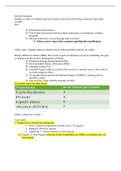NR228: Nutrition
Health-is a state of complete physical, mental, and social well-being, emotional, spiritually, socially.
Nut
Formal Education-School
Non-formal Education-American Heart Association or community wellness programs
Informal Education- occurs through daily activities
When a nurse chats with a patient regarding diet modification
Carbs= fuel—Simple (sugar) Complex (starch, fiber-provides no Kcals, no energy Dietary Reference Intakes (DRI)- How much experts recommend you eat of something, the goal to help prevent the chronic development of illness.
Estimated Average Requirement (EAR)
Recommended Dietary Allowance (RDA)
Adequate Intake (AI)
Tolerable Upper Intake Level (UL)-how much of a nutrient you can have before you have negative effect.
Acceptable Macronutrient Distribution Ranges (AMDRs)- counting macros (proteins, carbs)
Fats 20-35%, Carbs 45-65%, Proteins 10-35%.
Kilocalorie know the table below
Males 2 drinks per is mod, 1 Food labels
-1st thing to do is to read the serving size. oFree- Contains insignificant amount of fat (<0.5 grams)
oReduced- 25% less calories
oLight/Lite- 1/3 fewer calories, or 50% less fat
oOrganic vs Non-Organic- meat has to be no antibodies, no GMO, no synthesis fert., no pest control. chooseMyplate.gov
Requires 50% of grains should have whole grains.
Vegs 2 ½ cups/ per day
Fruit 2 cups/ day
Dairy= skim/low fat
Plant base diet is recommended
Best form of food is Fresh/ Raw vegs, then frozen, then canned foods.
Exchange List Created by the American Diabetes and the American Dietetic Association
Foods are divided into carbs, meats/meat subs, and fats.
Serving size provides similar amount of carbs, protein, fat, and kcal.
Most effective way to evaluation a Pt’s diet is a FOOD JOURNAL .
Carbs:
Carbs are made up of: organic compounds of carbon, hydrogen, and oxygen make up simple carbs
Simple: Monosaccharides (glucose, fructose) pass thought the GI easily.
Simple: Disaccharides [Sucrose (fructose + glucose)] Table sugar
Complex: Polysaccharides
Many units of monosaccharides held together by a chemical bond
Starch and fiber
Lactose “milk Sugar” (glut galactose)
Maltose (glu + glu) + fermentation = alcohol
gluconeogenesis-turning glycogen into glucose
Glycogenosis-turning glucose into glycogen Primary job of Carb metabolism- Maintaining blood glucose (BG) levels
Blood glucose levels can be maintained by metabolizing
Carbs- easily broken down, and easily converted into glucose
Lipids – Gluconeogenesis (ketosis)-turning fat into glucose, byproduct of ketones.
Proteins- gluconeogenesis-turning glycogen into glucose, byproduct is ammonia, excess is turned into fat BG levels are maintained through:
Carb metabolism
Fat metabolism
Ketones à Metabolic Acidosis
Stored Carbs
Glycogenosis-turning glucose into glycogen Nature Sources in the food supply Sugar cane and sugar beets
Honey, dextrose, and molasses Other sources, such as corn syrup and high-fructose corn syrup (HFCS) Sugar alcohols slower absorption effects:
Provide 2-3 kcals of energy
Occur naturally in fruits and berries
Sorbitol, Mannitol, and Xylitol Alternative sweeteners (artificial sweeteners) have no nutrient value:
Aspartame- found in diet sodas, 160-220% sweeter than sucrose. Phenylketonuria PKU Pt are not to eat this. Cannot process/ absorb Phenylalanine
Saccharin- Sweet N Low. 300x sweeter sucrose. Hx link to bladder cancer. Sucralose- Splenda. 600x sweeter sucrose. Poorly absorb be the body and excrete in the urine.
Stevia- Stevia- 200 x sweeter sucrose. Fiber
25-38 g/day
Most Americans adults average 16 g/day
Most Americans eat high protein & high fat diets & drink high sugared beverages
Americans consume high amounts of refined grains
Race/ethnicity
Mexican-Americans: fiber consumption is the highest
African Americans: fiber consumption is the lowest
Fiber cannot be broken down by digestive juices Fiber adds no nutritional value
Fiber creates bulk and eases the work of the GI muscles that regulate food movement
GI flora uses fiber as a medium for microbial fermentation for vitamin synthesis & formation short-chain fatty acids (SCFAs)
vitamin k, biotin, B12, folate, thiamin
SCFAs: used by the colon mucosa for energy (maintains the health of the colon epithelial cells) & increase fecal matter bulk
Soluble Fiber: dissolves in fluids
Thickens substances
Pectin , mucilage, psyllium seed husk, guar gum, Insoluble Fiber: does not dissolve in fluids
Cellulose , hemicellulose
Foods are classified by type of fiber
Less soluble: whole wheat, bran, fruits and mature veggies
More soluble: oats, legumes, barley, apples, carrots
Some are known to reduce cholesterol (oats, barley bran)
Refined Grains
We lose
-Bran- has cellulose (Fiber, Mg, Riboflavin, Thiamin, niacin
-Germ- Protein, Zinc
we keep endosperm- starch (energy) Protein, low niacin, thiamin, B6




